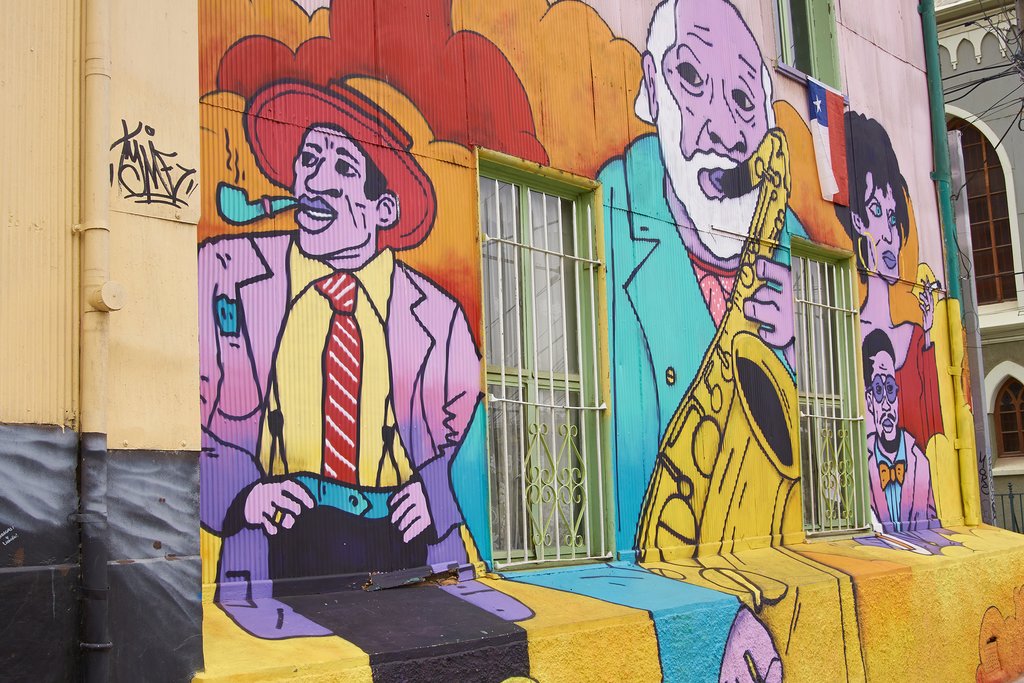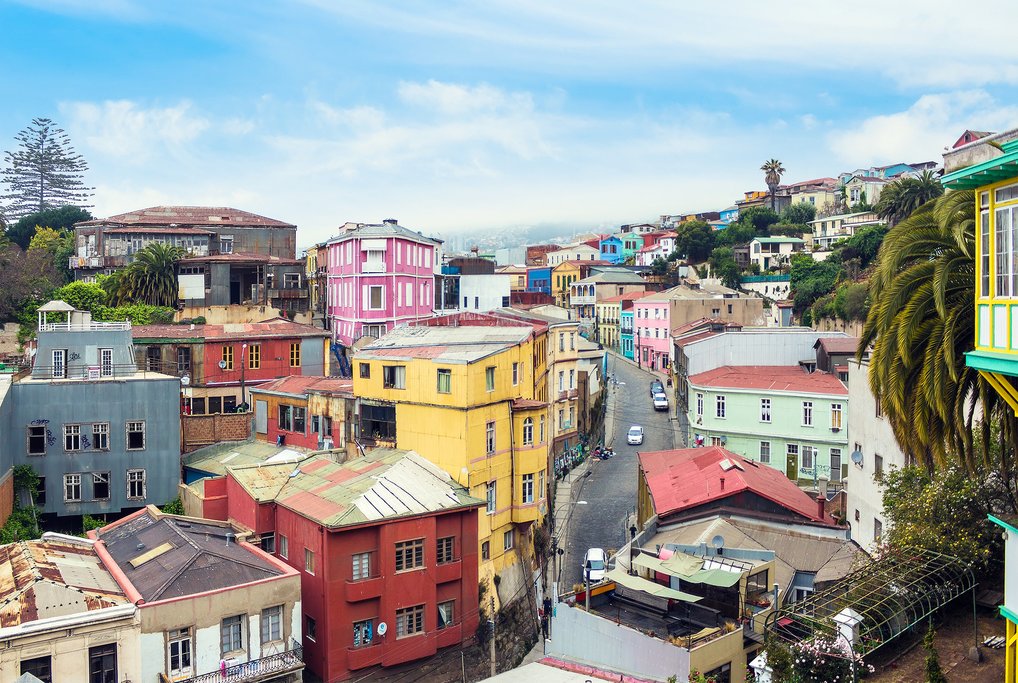Discover Valparaíso
Located 75 miles (120km) northwest of Santiago on Chile’s central coast, Valparaíso was once one of the world’s most important ports. Although it dates back to 1542, the city really came into its own after the country finally won its independence in 1821. International trade boomed and Valparaíso became a key port for ships traveling between Europe and the US west coast. Chile’s silver and copper booms provided further boosts, and foreign entrepreneurs flocked to the city.
But military engagements, a devastating earthquake, and, above all, the 1914 opening of the Panama Canal triggered a decline that lasted most of the twentieth century. In recent decades, however, the situation has improved significantly. In 1990, after the fall of the brutal Pinochet dictatorship, the Congress was moved to Valparaíso. The port also picked up, and many of the historic building were restored and turned into hotels and restaurants.
Today this city of 290,000 people is as essential a stop-off for tourists as it once was for international ships.
Planning Your Visit

A three-day trip allows you enough time to explore Valparaíso’s highlights and make a side-trip to the neighboring city of Viña del Mar or Isla Negra, the former home of Chile’s most famous poet, Pablo Neruda. Four or five days, though, allow for a more leisurely exploration. It’s also easy to include Valparaíso in a wider itinerary such as this 15-day trip, which also takes in Torres del Paine, San Pedro de Atacama, and Santiago, or this week-long tour, which includes skiing in Portillo.
Chilean tourist visas are available on arrival at airports and land borders for most nationalities and generally last 90 days. Some nationalities—including, at the time of writing, Canadians and Australians—must pay a “reciprocity fee”, an arrival tax equivalent to the amount Chilean travelers are charged for visiting the country in question. There is no malaria or yellow fever in Chile and no special vaccinations are required to visit. The tap water in Valparaíso is safe to drink, too.
The city has plenty of banks and ATMs, mostly located in the downtown, and credit and debit cards are widely accepted. For more practical logistics, see our Chile FAQ.
Weather
Valparaíso is a year-round destination. The summer, December to March, is pleasantly warm and dry, with lows of 52°F (11°C) and highs of 72°F (22°C). May to August is the wettest and coolest period, with temperatures ranging from 45°F (7°C) to 61°F (16°C). For more on weather in Chile, check out our monthly guides.
Security
Unfortunately, Valparaíso has some security issues. Pickpockets can be a problem throughout the city during the day, and the Barrio Puerto, some of the outlying cerros (hills), and parts of the downtown are not safe at night. Touristy cerros like Alegre and Concepción are generally safe, though it’s worth sticking to the main routes after dark.
Getting There & Around
The nearest major airport is in Santiago, 66 miles (106km) southeast. Valparaíso is fairly spread out but most places of interest are within walking distance of each other. The city has a modern, overground train service, the Metro. There are several Metro stations on the coastal strip and regular trains run to and from Viña del Mar. Frequent minibuses crisscross the city and also head to and from Viña del Mar. A series of vintage ascensores (funicular elevators) link points in the lower part of the city to the cerros, as do steep flights of steps.
Chat with a local specialist who can help organize your trip.
Highlights & Activities

Valparaíso’s colorful cerros, evocative port, and thriving cultural scene are the major highlights, but there are also some excellent museums, including one dedicated to Pablo Neruda. The city is also a great base for visits to the beaches and gardens of Viña del Mar.
Barrio Puerto
The atmospheric Barrio Puerto (Port Neighborhood) has a wealth of historic buildings, some beautifully preserved, others slowly crumbling. Highlights include the looming Aduana customs house, the Neoclassical La Matriz church, and the grand Plaza Sotomayor. This neighborhood is a bit rough around the edges (see the Security section above), so be on your guard.
Cerros Alegre and Concepción
These are two of Valparaíso’s most beautiful cerros, accessed via a pair of ascensores and covered with multicolored townhouses once owned by traders from around the world. They are also home to pretty churches, panoramic viewpoints, museums, arty shops, and scores of gorgeous places to eat, drink, sleep, and soak up the convivial atmosphere.
La Sebastiana
Once home to Nobel Prize-winning poet Pablo Neruda, La Sebastiana is now a memorable museum. High on a hill, it is filled with Neruda’s quirky possessions, which include collections of colored glasses, stuffed birds, nautical memorabilia, and wooden horses. Neruda enthusiasts should also head to the small village of Isla Negra, some 50 miles (80km) south of Valparaíso and home to another of the poet’s former homes, which has also been turned into a museum.
Navel and Maritime Museum
This large, well-laid-out museum provides an insight into Chile’s history and foremost political and military figures, including Ambrosio O’Higgins and Arturo Prat, whose names adorn countless streets across the country. There are also exhibits on the 33 San José miners dramatically rescued in 2010 after being trapped underground for 69 days in northern Chile.
Viña del Mar
A short journey north takes you to Viña del Mar, which has a completely different atmosphere to Valparaíso: ordered, leafy streets, modern apartment blocks, plenty of green spaces, and a long seafront promenade. As well as being Chile’s most popular beach resort, the city hosts the country’s biggest music events every February, the Festival Internacional de la Canción (International Music Festival).
Festivals & Special Events
Valparaíso is one of the most popular places in Chile to celebrate the New Year, and hosts a spectacular firework display. Accommodation prices rise sharply over this period and rooms get booked up quickly. On New Year’s Eve, the roads around Valparaíso also snarl up with traffic, so arrive early in the day or, even better, the day before.
Lodging & Dining

Where to Stay
Valparaíso is blessed with numerous excellent accommodation options, with the independently run guesthouses and B&Bs a particular strong point. The cerros, notably Alegre and Concepción, are the most atmospheric places to stay. Mid-range options include Hotel Da Vinci, which has suitably arty decor, and the Yellow House, which offers some of the finest vistas in town, plus friendly staff and economical rooms. At the luxury end of the scale, boutique hotel Casa Higueras boasts elegant rooms and spectacular views, while Palacio Astoreca offers classy rooms and swish service in a sumptuous mansion.
Where to Eat
Valparaíso is renowned for its excellent dining and drinking scene, with new joints springing up all the time. The popular Pasta e Vino provides sophisticated Italian food, Ápice has a creative, wide-ranging menu, and Vinilo offers up a modern take on classic Chilean dishes. For an earthier experience, head to J. Cruz Malbrán, a local institution that serves gut-busting chorrillanas, a pile of steak strips, French fries, eggs, and caramelized onions. If you’re after coffee, snacks, and wonderful ice cream, try Emporio La Rosa.
Valparaíso has a similarly eclectic range of drinking spots. The decidedly old school El Cinzano has live music on Thursday, Friday and Saturday nights, while Bar Inglés has the feel of a British pub. Fauna is a more modern option, with superlative views from the terrace and plenty of craft beers.
